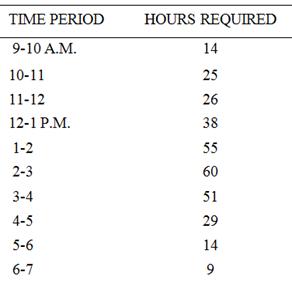The workload in many areas of bank operations has the characteristics of a non-uniform distribution with respect
Question:
A variable capacity can be achieved effectively by employing part-time personnel. Because part-timers are not entitled to all the fringe benefits, they are often more economical than full-time employees. Other considerations, however, may limit the extent to which part-time people can be hired in a given department. The problem is to find an optimum workforce schedule that would meet personnel requirements at any given time and also be economical.
.png)
Some of the factors affecting personnel assignment are listed here:
a. Full-time employees work for 8 hours per day, with a 1 hour break for lunch included.
b. Fifty percent of the full-timers go to lunch between 11
a. M. and noon, and the remaining 50% go between noon and 1 P.M.
c. Part-timers work for at least 4 continuous hours but no more than 7 continuous hours per day and are not allowed a lunch break.
d. By corporate policy, part-time personnel hours are limited to a maximum of 40% of the day€™s total requirement.
e. The shift starts at 9 A.M. and ends at 7 P.M. (i.e., overtime is limited to 2 hours). Any work left over at 7 P.M. is considered holdover for the next day.
f. A full-time employee is not allowed to work more than
1 hour of overtime per day. He or she is paid at the normal rate even for overtime hours€”not at one and one-half times the normal rate typically applicable to overtime hours. Fringe benefits are not applied to overtime hours.
In addition, the following costs are pertinent:
a. The average normal rate per full-time personnel hour is $24.08.
b. The fringe benefit rate per full-time personnel hour is charged at 25% the normal rate.
c. The average rate per part-time personnel hour is $17.82.
The personnel hours required, by hour of day, are given in Table 3.17. The bank€™s goal is to achieve the minimum possible Personnel cost subject to meeting or exceeding the hourly workforce requirements as well as the constraints on the workers listed earlier.
Personnel cost subject to meeting or exceeding the hourly workforce requirements as well as the constraints on the workers listed earlier.
Discussion Questions
1. What is the minimum-cost schedule for the bank?
2. What are the limitations of the model used to answer question 1?
The word "distribution" has several meanings in the financial world, most of them pertaining to the payment of assets from a fund, account, or individual security to an investor or beneficiary. Retirement account distributions are among the most...
Step by Step Answer:

Managerial Decision Modeling With Spreadsheets
ISBN: 9780136115830
3rd Edition
Authors: Nagraj Balakrishnan, Barry Render, Jr. Ralph M. Stair





